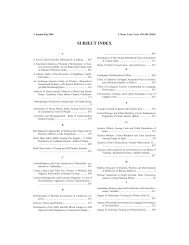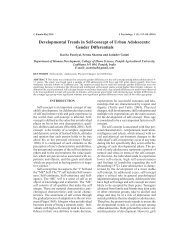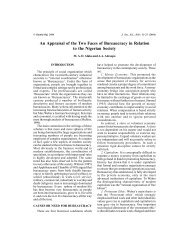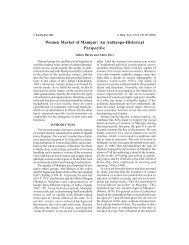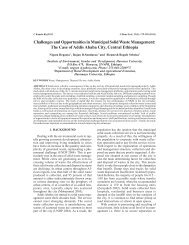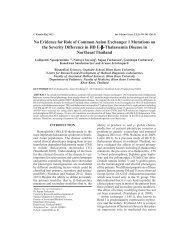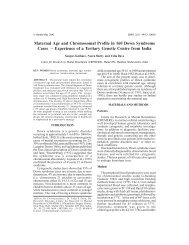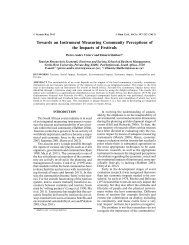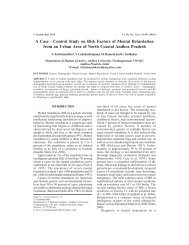Views on the Origins, Structure and Hierarchy of Some Niger Delta ...
Views on the Origins, Structure and Hierarchy of Some Niger Delta ...
Views on the Origins, Structure and Hierarchy of Some Niger Delta ...
Create successful ePaper yourself
Turn your PDF publications into a flip-book with our unique Google optimized e-Paper software.
© Kamla-Raj 2011 Anthropologist, 13(1): 47-59 (2011)<br />
<str<strong>on</strong>g>Views</str<strong>on</strong>g> <strong>on</strong> <strong>the</strong> <strong>Origins</strong>, <strong>Structure</strong> <strong>and</strong> <strong>Hierarchy</strong> <strong>of</strong> <strong>Some</strong> <strong>Niger</strong><br />
<strong>Delta</strong> Mud Sculpture Styles <strong>of</strong> Sou<strong>the</strong>rn <strong>Niger</strong>ia<br />
Ese Odokuma<br />
Department <strong>of</strong> Fine / Applied Arts, Faculty <strong>of</strong> Arts, <strong>Delta</strong> State University,<br />
Abraka, P.M.B 1 <strong>Niger</strong>ia<br />
Teleph<strong>on</strong>e: + 234 – 8026 340780, + 234 – 8060 385695, E-mail: eseodokuma2@yahoo.com<br />
KEYWORDS Custodian. M<strong>on</strong>tage. Furrow. Venerati<strong>on</strong>. Propagati<strong>on</strong> .Reverence. Rich Metropolis. Custom. Ritual<br />
ABSTRACT Mud sculptures are comm<strong>on</strong> artistic idioms erected <strong>and</strong> c<strong>on</strong>structed in some <strong>Niger</strong> <strong>Delta</strong> communities <strong>of</strong><br />
sou<strong>the</strong>rn <strong>Niger</strong>ia. Various sizes <strong>and</strong> structures ranging from naturalistic to abstracted types exist. C<strong>on</strong>sequently, <strong>the</strong><br />
need to determine <strong>the</strong> initial ancestry locati<strong>on</strong> became necessary, particularly as regards <strong>the</strong> c<strong>on</strong>centrati<strong>on</strong> <strong>of</strong> this art<br />
form as well as its’ characteristic spread in <strong>the</strong> regi<strong>on</strong>. Evidence <strong>of</strong> hierarchical traits <strong>and</strong> certain formal similarities<br />
initially point at Benin but fur<strong>the</strong>r investigati<strong>on</strong>s show more western Igbo influences than those <strong>of</strong> Benin. That <strong>the</strong><br />
origins <strong>of</strong> <strong>the</strong> medium <strong>and</strong> c<strong>on</strong>cept, particularly those representing Olokun, most likely stemmed from <strong>the</strong> western<br />
Igbo area <strong>and</strong> later spread to o<strong>the</strong>r neighbouring areas through <strong>the</strong> river Ethiope, is probable.<br />
INTRODUCTION<br />
This paper examines <strong>the</strong> origins, structures<br />
<strong>and</strong> hierarchy in some <strong>Niger</strong> <strong>Delta</strong> mud sculptures<br />
<strong>of</strong> sou<strong>the</strong>rn <strong>Niger</strong>ia.<br />
Located in <strong>the</strong> sou<strong>the</strong>rn part <strong>of</strong> <strong>Niger</strong>ia, is <strong>the</strong><br />
<strong>Niger</strong> <strong>Delta</strong>, which comprises: <strong>Delta</strong>, Bayelsa,<br />
Rivers, Edo, Imo, Cross River, Akwa Ibom <strong>and</strong><br />
Ondo States. It is a regi<strong>on</strong> which c<strong>on</strong>sists <strong>of</strong> abundant<br />
natural supplies <strong>of</strong> crude oil, diverse mineral<br />
resources <strong>and</strong> fertile l<strong>and</strong>s. O<strong>the</strong>r substances<br />
such as clay (Pearsal 1991) <strong>and</strong> mud (Peek 1976)<br />
also exist in large quantities across <strong>the</strong> <strong>Niger</strong> <strong>Delta</strong><br />
States.<br />
Quite a few mud sculpture tableaus are located<br />
in several communities across <strong>the</strong> <strong>Niger</strong> <strong>Delta</strong>.<br />
Most are built near <strong>the</strong> river, whilst o<strong>the</strong>rs are<br />
erected at <strong>the</strong> edge or within forest grooves <strong>of</strong><br />
<strong>the</strong> town. <strong>Some</strong> <strong>of</strong> <strong>the</strong>se tableaus show diverse<br />
styles <strong>of</strong> naturalism, stylizati<strong>on</strong> <strong>and</strong> abstracted<br />
forms. There are even traces <strong>of</strong> interacti<strong>on</strong> as<br />
well as multiplicity <strong>of</strong> forms in <strong>the</strong> works. This<br />
study however aims at ascertaining <strong>the</strong> origins<br />
<strong>of</strong> mud sculptures in <strong>the</strong> <strong>Niger</strong> <strong>Delta</strong> regi<strong>on</strong>,<br />
particularly works affiliated with Olokun worship.<br />
In o<strong>the</strong>r to examine this work appropriately, certain<br />
methods such as <strong>the</strong> classificatory, analytical,<br />
descriptive <strong>and</strong> interpretati<strong>on</strong>al forms <strong>of</strong> deducti<strong>on</strong><br />
were employed. Selected areas including<br />
some western Igbo, Urhobo, Isoko, Ijo <strong>and</strong> Benin<br />
towns were chosen for <strong>the</strong> purpose.<br />
Having provided a background to this study,<br />
an attempt is <strong>the</strong>refore made to first discuss <strong>the</strong><br />
source <strong>of</strong> <strong>the</strong> Olokun c<strong>on</strong>cept as well as <strong>the</strong> Benin<br />
origins <strong>of</strong> some <strong>of</strong> <strong>the</strong>se cultures, since most <strong>of</strong><br />
<strong>the</strong>m trace <strong>the</strong>ir origins to this ancient kingdom.<br />
The structure, hierarchical elements as well as<br />
<strong>the</strong> ic<strong>on</strong>ography <strong>of</strong> <strong>the</strong>ir mud sculpture would<br />
also be examined.<br />
Origin <strong>of</strong> <strong>the</strong> Worship <strong>of</strong> <strong>the</strong> Olokun River<br />
Goddess<br />
“Olokun” is a river goddess associated with<br />
wealth <strong>and</strong> <strong>the</strong> provisi<strong>on</strong> <strong>of</strong> children. It is a<br />
traditi<strong>on</strong>al cult comm<strong>on</strong> to most parts <strong>of</strong> sou<strong>the</strong>rn<br />
<strong>Niger</strong>ia. Cultures like <strong>the</strong> Yoruba, Edo, Urhobo,<br />
western Igbo, Ijo <strong>and</strong> o<strong>the</strong>r areas in <strong>the</strong> south,<br />
practice this traditi<strong>on</strong>. But it is more prevalent<br />
am<strong>on</strong>g <strong>the</strong> Benin <strong>and</strong> her immediate western Igbo<br />
neighbours. In Benin culture, Olokun can be<br />
looked up<strong>on</strong> as a god or goddess <strong>of</strong> <strong>the</strong> sea. The<br />
Benin shrine dedicated to Olokun is located in<br />
two major areas namely: Urhi<strong>on</strong>igbe <strong>and</strong> Evboise<br />
in Edo State, although <strong>of</strong> course many more sites<br />
exist. The Urhi<strong>on</strong>igbe Site is s<strong>and</strong>wiched between<br />
two <strong>Delta</strong> areas <strong>of</strong> Umutu (Ndokwa) <strong>and</strong> Abavo<br />
(Ika south), all in <strong>Delta</strong> State. These areas also<br />
have large representati<strong>on</strong>s <strong>of</strong> Onoku(Olokun)<br />
figures (Fig. 1).<br />
Olokun in Evboise was said to have originated<br />
from Ethiope river in <strong>Delta</strong> State. Oral traditi<strong>on</strong><br />
suggests that before Oba Adolor became king,<br />
his mo<strong>the</strong>r sought protecti<strong>on</strong> against pre-mature<br />
death, so that he could rule when <strong>the</strong> time came.<br />
The <strong>on</strong>ly soluti<strong>on</strong> at that time was to go to <strong>the</strong>
48<br />
Whydah<br />
Badagry<br />
B I G H T<br />
O F<br />
B E N I N<br />
0 40 80 km<br />
Y O R U B A<br />
Fig. 1. Map showing areas, towns <strong>and</strong> peoples menti<strong>on</strong>ed in this study<br />
goddess <strong>of</strong> <strong>the</strong> river. The request was granted<br />
<strong>and</strong> subsequently a shrine was erected in h<strong>on</strong>our<br />
<strong>of</strong> Olokun in Evboise.<br />
The Urhi<strong>on</strong>igbe versi<strong>on</strong> comes in two forms.<br />
The first versi<strong>on</strong> reveals that a woman coming<br />
from <strong>the</strong> farm with yams <strong>on</strong> her head was<br />
suddenly possessed by Olokun which in turn<br />
led to her c<strong>on</strong>fusi<strong>on</strong> <strong>and</strong> eventual death. After<br />
three years, according to Beier (1963), she<br />
suddenly reappeared not carrying yams but as<br />
carrying a stool which was believed to have come<br />
from heaven. Beier (1963) describes <strong>the</strong> stool as<br />
having a pattern that nobody had seen before<br />
<strong>and</strong> which nobody could repeat. She was reported<br />
to have danced around <strong>the</strong> town humming<br />
an accompaniment. This dance is still being<br />
performed annually at Urh<strong>on</strong>igbe as <strong>the</strong> “Ekabo”<br />
dance. It was she who instructed that <strong>the</strong> Olokun<br />
shrine be built in Urh<strong>on</strong>igbe.<br />
The sec<strong>on</strong>d versi<strong>on</strong> attributes its origin to<br />
<strong>on</strong>e “Okuase”,a hunter from a neighbouring town<br />
<strong>of</strong> “Ulu,” who w<strong>and</strong>ered into <strong>the</strong> bush with his<br />
dog. According to <strong>the</strong> traditi<strong>on</strong>, it was prohibited<br />
to go hunting with a dog. As a result, he was<br />
<strong>the</strong>n possessed by <strong>the</strong> river Ethiope which<br />
overwhelmed him <strong>and</strong> sucked him to <strong>the</strong> bottom<br />
<strong>of</strong> <strong>the</strong> river. In <strong>the</strong> river, he was introduced to <strong>the</strong><br />
deity Olokun <strong>and</strong> was made to stay in it for three<br />
years. During his stay, he learnt many spiritual<br />
Okitipupa<br />
Otun<br />
AKURE<br />
Mohin<br />
Owo<br />
Siluko<br />
BENIN CITY<br />
ITSEKIRI<br />
Auchi<br />
Ubiaja<br />
Onitsha<br />
Urh<strong>on</strong>igbe<br />
URHOBO<br />
Watti<br />
I J O<br />
ESE ODOKUMA<br />
IGALA<br />
Idah<br />
LOWE R ASABA<br />
WESTERN I G B O<br />
ISOKO<br />
sciences <strong>and</strong> practices associated with Olokun.<br />
Although he was assumed dead by his community,<br />
after three years he returned, with a pot <strong>on</strong><br />
his head, dancing in <strong>the</strong> middle <strong>of</strong> <strong>the</strong> town. It is<br />
this dance, that later metamorphosized into <strong>the</strong>14day<br />
dance ritual to Olokun <strong>and</strong> re-enacted during<br />
<strong>the</strong>ir annual festival which is called <strong>the</strong> “Ekabo”<br />
dance.<br />
Beier (1963) c<strong>on</strong>firms that all Olokun worshippers<br />
in Benin seem to agree that <strong>the</strong> cult stems<br />
from a small Benin village called Urh<strong>on</strong>igbe. Beier<br />
(1963) quoting Okaivbo, stresses that <strong>the</strong> spirit<br />
<strong>of</strong> Olokun is said to be derived two miles from<br />
Urh<strong>on</strong>igbe in a little river which is <strong>the</strong> source <strong>of</strong><br />
<strong>the</strong> river Ethiope. However, <strong>the</strong>se stories seem to<br />
point at <strong>the</strong> same area <strong>of</strong> origin in <strong>the</strong> <strong>Niger</strong> <strong>Delta</strong><br />
or <strong>the</strong> Ethiope river. It is this evidence that<br />
motivated <strong>the</strong> initial intenti<strong>on</strong> to study <strong>the</strong> precise<br />
origin <strong>of</strong> this c<strong>on</strong>cept.<br />
A number <strong>of</strong> scholars including, Foss, Peek,<br />
Eg<strong>on</strong>wa, Dark, Ben-Amos, Mack, J<strong>on</strong>es, Bradbury<br />
<strong>and</strong> a few o<strong>the</strong>rs have given <strong>the</strong>ir views as regarding<br />
<strong>the</strong> origins, significance <strong>and</strong> classificati<strong>on</strong>s<br />
<strong>of</strong> <strong>the</strong>se mud sculptures.<br />
Foss (1976) believes that <strong>the</strong>se images are reworking<br />
<strong>of</strong> clay – modeling traditi<strong>on</strong>s developed<br />
by both <strong>the</strong> Benin people to <strong>the</strong> north <strong>and</strong> certain<br />
Igbo groups to <strong>the</strong> east Peek (1976) goes <strong>on</strong> to<br />
ascribe Igbo overlays to <strong>the</strong> mud sculptures <strong>of</strong><br />
N I G E R R I VER
VIEWS ON THE ORIGINS, STRUCTURE AND HIERARCHY<br />
<strong>the</strong> Isoko people. Eg<strong>on</strong>wa (1994) links some<br />
<strong>Niger</strong> <strong>Delta</strong> mud sculpture styles to those <strong>of</strong> Ijo<br />
or Benin descent. Dark (1973) tells us about<br />
<strong>the</strong> two discernable styles <strong>of</strong> Benin mud sculpture,<br />
which reflects <strong>the</strong> distincti<strong>on</strong>s William Fagg<br />
made. They are <strong>the</strong> court <strong>and</strong> plebeian styles.<br />
Ben-Amos (1973) made a remark <strong>on</strong> <strong>the</strong> relati<strong>on</strong>ship<br />
between court <strong>and</strong> plebeian styles. According<br />
to her, imagery <strong>and</strong> <strong>the</strong> spatial compositi<strong>on</strong><br />
possessed by <strong>the</strong>se sculptures are closely<br />
related to <strong>the</strong> Benin court art. Cited by Peek (1976)<br />
in his sacred “Mud sculptures”, Ben-Amos also<br />
suggests that Olokun at least by name may be<br />
Yoruba in Origin.<br />
J<strong>on</strong>es <strong>and</strong> Bradbury (1975) see Owerri as <strong>the</strong><br />
stimulus, resulting in <strong>the</strong> Edo <strong>and</strong> western Igbo<br />
elaborate mud sculptures. In <strong>the</strong> same document,<br />
Bradbury (1975) also points out that <strong>the</strong> c<strong>on</strong>cept<br />
<strong>of</strong> mud sculptures were relatively recent introducti<strong>on</strong>s<br />
in Benin City.<br />
Benin Historical <strong>Origins</strong> <strong>of</strong> <strong>Some</strong> <strong>of</strong> <strong>the</strong><br />
Menti<strong>on</strong>ed Cultures<br />
Most cultures in <strong>the</strong> <strong>Niger</strong> <strong>Delta</strong>, particularly<br />
those located in <strong>Delta</strong> State, trace <strong>the</strong>ir origins to<br />
Benin. These cultures include Urhobo, Isoko,<br />
Ukwuani, Western Igbo <strong>and</strong> some Ijo groups.<br />
<strong>Some</strong> <strong>of</strong> <strong>the</strong>se claims date as far back as between<br />
<strong>the</strong> fourteen to <strong>the</strong> sixteenth century A. D. The<br />
reas<strong>on</strong>s for <strong>the</strong>se similar dates are diverse.<br />
Perhaps, that was <strong>the</strong> period when <strong>the</strong> Benin Obas<br />
(kings) exerted <strong>the</strong>ir authority <strong>and</strong> sovereignty<br />
over <strong>the</strong>ir neighbours.<br />
Egharevba (1968) in his book “A Short<br />
History <strong>of</strong> Benin” c<strong>on</strong>firms <strong>the</strong> Benin lordship<br />
over <strong>the</strong>se cultures. He claims that<br />
…<strong>the</strong> early peoples <strong>of</strong> Ishan <strong>and</strong> Afenmai<br />
Divisi<strong>on</strong>s, <strong>the</strong> Eka <strong>and</strong> Ibo – speaking peoples<br />
<strong>of</strong> <strong>the</strong> west bank <strong>of</strong> <strong>the</strong> <strong>Niger</strong>, Aboh, <strong>the</strong> Urhobo,<br />
Isoko <strong>and</strong> <strong>the</strong> people <strong>of</strong> Onitsha are all<br />
emigrants from Benin.<br />
Speaking <strong>on</strong> <strong>the</strong> Urhobo, Otite (2003)<br />
however believes that at <strong>the</strong> end <strong>of</strong> <strong>the</strong> Ogiso<br />
(rulers) dynasty, many Urhobo <strong>and</strong> o<strong>the</strong>r Edo<br />
groups left Udo in different directi<strong>on</strong>s. Ikimi<br />
(1984) attests to <strong>the</strong> Benin origin <strong>of</strong> some Urhobo<br />
settlements such as Ughelli, Ogor, Agb<strong>on</strong>,<br />
Agbarho, Agbarha, Abraka, Oghara, Okpe, Olomu,<br />
Uvwie, Effuruntor <strong>and</strong> Uwhenru. This view is<br />
also supported by Adjara <strong>and</strong> Omokri (1997). Ekeh<br />
(2006) went ahead to classify into three stages<br />
<strong>the</strong> likely periods <strong>of</strong> Urhobo history. They inc-<br />
lude: Ancient Times, Middle Ages <strong>and</strong> Modern<br />
Times.<br />
The origins <strong>of</strong> <strong>the</strong> western Igbo clans are not<br />
viewed differently. Henders<strong>on</strong> (1972) recalls that<br />
<strong>the</strong> founders <strong>of</strong> Onitsha <strong>and</strong> Agbor were from<br />
Benin. Beier (1963) even attaches <strong>the</strong> historical<br />
c<strong>on</strong>necti<strong>on</strong>s between Agbor <strong>and</strong> Benin to<br />
Ezechima who was said to be <strong>on</strong>e <strong>of</strong> <strong>the</strong> s<strong>on</strong>s <strong>of</strong><br />
<strong>the</strong> Oba <strong>of</strong> Benin. Isichei (1977) quoting Osu,<br />
points at some western Igbo communities as<br />
originating from Benin. They include: Onitsha –<br />
Ol<strong>on</strong>a, Onitsha Ugbo, Issele-Ukwu <strong>and</strong> Agbor.<br />
Onwuejeogwu (1981) however supports <strong>the</strong><br />
claim <strong>of</strong> Benin origin <strong>of</strong> some major western Igbo<br />
communities <strong>of</strong> Ossissa, Onitsha, Aboh <strong>and</strong><br />
Agbor.<br />
As regards <strong>the</strong> Ukwuani group, Okolugbo<br />
(1978) submits <strong>the</strong> following view:<br />
…many <strong>of</strong> <strong>the</strong> Ukwuani clans trace <strong>the</strong>ir<br />
origins to Benin. The first wave <strong>of</strong> migrati<strong>on</strong>s is<br />
represented by Umukashiade, Ebedei <strong>and</strong><br />
Akarai clans <strong>and</strong> <strong>the</strong>ir <strong>of</strong>fshoots, <strong>the</strong> sec<strong>on</strong>d was<br />
brought Abara, Uto-Oku, Umu-barauchi, Nd<strong>on</strong>i,<br />
Onya <strong>and</strong> Adai <strong>and</strong> <strong>the</strong> third which led to <strong>the</strong><br />
rise <strong>of</strong> Aboh Kingdom, came from Benin.<br />
Writing <strong>on</strong> <strong>the</strong> Ijo group, Le<strong>on</strong>ard (1968)<br />
suggests a break away <strong>of</strong> <strong>the</strong> group from Benin<br />
as follows;<br />
…In a way, it is tolerably evident <strong>the</strong> first <strong>of</strong><br />
all originated from <strong>the</strong> latter <strong>and</strong> <strong>the</strong>n after<br />
breaking away from <strong>the</strong>m, remained under <strong>the</strong><br />
sovereignty <strong>of</strong> <strong>the</strong>ir king… <strong>and</strong> as time went <strong>on</strong><br />
<strong>and</strong> synchr<strong>on</strong>ously with <strong>the</strong> dwindling power <strong>of</strong><br />
<strong>the</strong> present m<strong>on</strong>archy this c<strong>on</strong>necti<strong>on</strong> loosened<br />
<strong>and</strong> lessened…<br />
Alagoa <strong>and</strong> Kiebel (1989) comment <strong>on</strong> <strong>the</strong><br />
claims <strong>of</strong> Benin origin am<strong>on</strong>gst some Ijo clans <strong>of</strong><br />
<strong>the</strong> <strong>Delta</strong> <strong>and</strong> Ondo States. Their claims were<br />
based <strong>on</strong> some reports written in <strong>the</strong> 1930s which<br />
indicate that five clans <strong>of</strong> western Ijo, Benin,<br />
Tarakiri, Kabowei, Kumbowei <strong>and</strong> Mein menti<strong>on</strong>ed<br />
Benin as <strong>the</strong>ir origin.<br />
Likely Hierarchical C<strong>on</strong>ceptual <strong>Origins</strong><br />
Am<strong>on</strong>gst <strong>the</strong> Menti<strong>on</strong>ed Cultures<br />
49<br />
Most Benin brass plaques classified by Fagg<br />
in <strong>the</strong> sixteenth century show traces <strong>of</strong> hierarchy.<br />
The c<strong>on</strong>cept <strong>of</strong> hierarchy in African art, however<br />
pre-dates <strong>the</strong> fifteenth to eighteenth centuries.<br />
Dates associated with <strong>the</strong> hierarchical trait goes<br />
bey<strong>on</strong>d three thous<strong>and</strong> years ago. Historically, it<br />
is evident that ancient Egyptian <strong>and</strong> Sudanese
50<br />
cultures portrayed traits <strong>of</strong> hierarchy(Dorling<br />
1994). The Egyptian artist for instance, aimed at<br />
reflecting social <strong>and</strong> religious hierarchies in <strong>the</strong>ir<br />
compositi<strong>on</strong>s <strong>and</strong> assigned proporti<strong>on</strong>s to figures<br />
whose relati<strong>on</strong>ship to <strong>on</strong>e ano<strong>the</strong>r were c<strong>on</strong>stant<br />
(Mack 2000).<br />
Traces <strong>of</strong> <strong>the</strong> hierarchical structures displayed<br />
in some <strong>Niger</strong> <strong>Delta</strong> mud sculptures seems to<br />
transcend bey<strong>on</strong>d <strong>the</strong> horiz<strong>on</strong>s <strong>of</strong> Benin influence.<br />
Since Benin oral traditi<strong>on</strong> supports its<br />
(Benin’s) migrati<strong>on</strong> from Egypt <strong>and</strong> later from<br />
Sudan (Egharveba 1968), could it <strong>the</strong>n be argued,<br />
that <strong>the</strong> hierarchical elements in her works were<br />
derived from Egyptian <strong>and</strong> Sudanese influences?<br />
Most <strong>of</strong> <strong>the</strong> figures in some <strong>Niger</strong> delta mud<br />
shrines have in <strong>the</strong> central positi<strong>on</strong> an Oba-like<br />
depicti<strong>on</strong> <strong>of</strong> a king. It is indeed apparent that<br />
some cultural mixtures can be seen in <strong>the</strong>se<br />
c<strong>on</strong>cepts. However, hierarchy seems to be an<br />
African c<strong>on</strong>cept that is in most cases, sp<strong>on</strong>taneously<br />
developed, not derived from o<strong>the</strong>r<br />
cultures but shared by <strong>the</strong>m. The hierarchical<br />
c<strong>on</strong>cept in Benin traditi<strong>on</strong> can also be reflected<br />
in <strong>the</strong> story <strong>of</strong> Olokun’s battle .<br />
Oral traditi<strong>on</strong> tells us that Olokun <strong>and</strong> <strong>the</strong> Oba<br />
were engaged in a battle were Olokun’s possessi<strong>on</strong>s<br />
was stripped. This act al<strong>on</strong>e shows a form<br />
<strong>of</strong> hierarchy between <strong>the</strong> Oba <strong>and</strong> Olokun; as<br />
Olokun is now depicted as an Oba. Since <strong>the</strong> Oba<br />
defeated Olokun, <strong>the</strong> latter takes <strong>the</strong> physical<br />
form <strong>of</strong> <strong>the</strong> Oba. In o<strong>the</strong>r words, Olokun before<br />
<strong>the</strong>n had a visual representati<strong>on</strong> <strong>of</strong> its own but<br />
that had changed as result <strong>of</strong> <strong>the</strong> c<strong>on</strong>quest. This<br />
battle could also portray <strong>the</strong> subjugati<strong>on</strong> <strong>of</strong> areas<br />
where Olokun was discovered by <strong>the</strong> Benin<br />
empire.<br />
Mack (2000) c<strong>on</strong>firms <strong>the</strong> Benin traditi<strong>on</strong> <strong>of</strong><br />
<strong>the</strong> battle between <strong>the</strong> Oba <strong>and</strong> Olokun but,<br />
symbolically relates it to Benin <strong>and</strong> European<br />
c<strong>on</strong>tact. Here, he claims that <strong>the</strong> Europeans were<br />
associated with <strong>the</strong> white faced god, Olokun who<br />
lived bey<strong>on</strong>d <strong>the</strong> sea <strong>and</strong> sends children <strong>and</strong><br />
wealth. Legend had it that, after Benin’s defeat<br />
<strong>of</strong> Olokun, <strong>the</strong> Oba stripped him <strong>of</strong> his properties.<br />
This act represents <strong>the</strong> m<strong>on</strong>opoly <strong>of</strong> foreign<br />
trade in Benin where eventually <strong>the</strong> European<br />
manufactures were melted down <strong>and</strong> recast in<br />
<strong>the</strong> Oba’s court as a sign <strong>of</strong> c<strong>on</strong>quest. Or it may<br />
represent <strong>the</strong> c<strong>on</strong>flict between Benin <strong>and</strong> o<strong>the</strong>r<br />
smaller communities around it. Whatever <strong>the</strong> case<br />
may be, <strong>the</strong> trait <strong>of</strong> hierarchy seems to be depicted<br />
in this legend.<br />
As regards <strong>the</strong> origin <strong>of</strong> <strong>the</strong> Olokun cult,<br />
ESE ODOKUMA<br />
evidence <strong>of</strong> western Igbo invasi<strong>on</strong> had been<br />
chr<strong>on</strong>icled in some Benin plaques <strong>and</strong> oral<br />
traditi<strong>on</strong>s. Facial markings not identified as Benin<br />
types had been recorded <strong>and</strong> analysed. Thus,<br />
<strong>the</strong> likelihood <strong>of</strong> Olokun as a king <strong>of</strong> <strong>the</strong> Western<br />
Igbo origin or some o<strong>the</strong>r riverine area in <strong>the</strong> <strong>Niger</strong><br />
<strong>Delta</strong> is probable, c<strong>on</strong>sidering <strong>the</strong> story <strong>of</strong> its<br />
origin in Benin traditi<strong>on</strong>. The white faces <strong>on</strong> <strong>the</strong><br />
deities may not signify Europeans or spirits. They<br />
may simply st<strong>and</strong> for purity <strong>and</strong> reverence.<br />
There is also <strong>the</strong> probability that <strong>the</strong> c<strong>on</strong>cept<br />
<strong>of</strong> Olokun c<strong>on</strong>sists <strong>of</strong> two or more variables: <strong>the</strong><br />
initial foundati<strong>on</strong>s <strong>of</strong> <strong>the</strong> Olokun ideology, <strong>the</strong><br />
European c<strong>on</strong>tact, <strong>and</strong> <strong>the</strong> Western Igbo incursi<strong>on</strong>s.<br />
Thus, although <strong>the</strong> Olokun is depicted<br />
“white” “he has more black qualities <strong>and</strong> origins.”<br />
To buttress this view, is <strong>the</strong> fact that, <strong>the</strong><br />
Europeans were not <strong>the</strong> <strong>on</strong>ly <strong>on</strong>es who travelled<br />
by sea, some <strong>Niger</strong> delta neighbours had also<br />
migrated to <strong>the</strong> Benin kingdom through <strong>the</strong> sea.<br />
Cultures like <strong>the</strong> Urhobo, Isoko, Ijo, Itsekiri <strong>and</strong><br />
Western Igbo groups had migrated through <strong>the</strong><br />
water ways before <strong>the</strong> advent <strong>of</strong> <strong>the</strong> Europeans<br />
in <strong>the</strong> <strong>Niger</strong> <strong>Delta</strong>. Possibly, <strong>the</strong> c<strong>on</strong>cept was<br />
carried from <strong>on</strong>e locati<strong>on</strong> by sea to o<strong>the</strong>r areas,<br />
particularly through <strong>the</strong> Ethiope River.<br />
Classificati<strong>on</strong>, Analysis, Descripti<strong>on</strong> <strong>and</strong><br />
Interpretati<strong>on</strong> <strong>of</strong> <strong>Some</strong> <strong>Niger</strong> <strong>Delta</strong> Mud<br />
Sculpture Styles<br />
The styles <strong>of</strong> some <strong>of</strong> <strong>the</strong>se mud sculptures<br />
vary in form <strong>and</strong> style. While some are naturalistic,<br />
o<strong>the</strong>rs are stylized <strong>and</strong> a few o<strong>the</strong>rs are abstracted.<br />
Despite <strong>the</strong> fact that <strong>the</strong> individual h<strong>and</strong> <strong>of</strong><br />
<strong>the</strong> artist is <strong>of</strong>ten c<strong>on</strong>sidered, a classificati<strong>on</strong> <strong>of</strong><br />
<strong>the</strong> distributi<strong>on</strong> <strong>of</strong> some mud sculptures show<br />
that <strong>the</strong> Western Igbo group c<strong>on</strong>sisting <strong>of</strong> <strong>the</strong><br />
Ukwuani <strong>and</strong> Abavo areas, seem to possess <strong>the</strong><br />
most naturalistic <strong>and</strong> numerous representati<strong>on</strong>s<br />
<strong>of</strong> mud sculptures. For that reas<strong>on</strong>, we shall first<br />
attempt an analysis <strong>of</strong> this study area.<br />
The four most important mud sculpture<br />
tableaus used in this study derive from <strong>the</strong> western<br />
Igbo areas <strong>of</strong> Ozanogogo, Abavo, Ukwuani<br />
<strong>and</strong> Umuaja They all stretched al<strong>on</strong>g <strong>the</strong> path<br />
from Obiaruku to <strong>the</strong> Asaba areas.<br />
However, certain pers<strong>on</strong>s seem to disassociate<br />
<strong>the</strong> Ukwuani group as being members <strong>of</strong> <strong>the</strong><br />
western Igbo classificati<strong>on</strong>. C<strong>on</strong>sidering <strong>the</strong><br />
linguistic <strong>and</strong> cultural as well as historic attributes<br />
<strong>of</strong> this study, <strong>the</strong> Western Igbo <strong>and</strong> Ukwuani will<br />
be lumped toge<strong>the</strong>r as <strong>on</strong>e.
VIEWS ON THE ORIGINS, STRUCTURE AND HIERARCHY<br />
Mud sculptures in <strong>the</strong> Western Igbo area<br />
seem to revere <strong>the</strong> spirits <strong>of</strong> Olokun or Onoku,<br />
<strong>the</strong> water god. However, <strong>the</strong> issue <strong>of</strong> hierarchy is<br />
evidently obvious in all <strong>the</strong> works displayed.<br />
In 2004, five figures <strong>of</strong> Onoku were housed in<br />
a small building at Ozanogogo. These works were<br />
partially semi-naturalistic. Am<strong>on</strong>gst <strong>the</strong> five<br />
depicted figures was a seated central figure which<br />
was flanked by <strong>on</strong>e female <strong>and</strong> male statue. On<br />
<strong>the</strong> left was a maternite figure with child. The<br />
maternite figure seemed to be <strong>the</strong> wife <strong>of</strong> <strong>the</strong><br />
central figure. With certain paraphernalia <strong>on</strong> <strong>the</strong><br />
head, it wore a particular form <strong>of</strong> coiffure. The<br />
eyes, nose, mouth <strong>and</strong> ears seem to be very expressive<br />
<strong>of</strong> thought <strong>and</strong> naturalistically depicted.<br />
There is a form <strong>of</strong> alertness in <strong>the</strong> statue. Around<br />
<strong>the</strong> figure’s neck are beads as it clings tight to it’s<br />
baby.<br />
Certain bottles <strong>of</strong> bleach, wine, cream, may<br />
have been to be used to appease <strong>the</strong> goddess in<br />
request for children. In order words, this figure<br />
represents fertility. Next to <strong>the</strong> central figure <strong>on</strong><br />
<strong>the</strong> right is a male figure carrying similar structure<br />
<strong>on</strong> its head.<br />
The face is just like <strong>the</strong> female maternite except<br />
that it has a str<strong>and</strong> <strong>of</strong> beard under its chin.<br />
It also seems to be pointing a cutlass at <strong>the</strong> central<br />
figure, possibly suggesting its (central figures’)<br />
superiority over <strong>the</strong> o<strong>the</strong>rs. Displayed in its<br />
fr<strong>on</strong>t are also c<strong>on</strong>tainers, bottles, charms, jars<br />
ammuniti<strong>on</strong>s as well as sticks <strong>of</strong> varied forms.<br />
There are also c<strong>and</strong>les, cowries <strong>and</strong> pieces <strong>of</strong><br />
native chalk dotted in fr<strong>on</strong>t <strong>of</strong> this figurative.<br />
O<strong>the</strong>r objects including a moulded basin – like<br />
structure <strong>and</strong> some metal rods are evident. These<br />
objects are probably used to appease <strong>the</strong> gods.<br />
Mirrors are also comm<strong>on</strong> with in this cult as in<br />
o<strong>the</strong>r Olokun shrines. Dots <strong>of</strong> red, yellow <strong>and</strong><br />
black form <strong>the</strong> surrounding designs <strong>of</strong> <strong>the</strong> mirror<br />
(See Fig. 2). These colourful shapes may be coded<br />
which embody some <strong>of</strong> <strong>the</strong> mysteries <strong>of</strong> <strong>the</strong> shrine<br />
– assemblage.<br />
Next to this figure <strong>on</strong> <strong>the</strong> right is a smaller<br />
figure with similar features, <strong>on</strong>ly it seems to be<br />
less dramatic than <strong>the</strong> o<strong>the</strong>rs (Fig.2).<br />
The soldier who acts as a security agent<br />
st<strong>and</strong>s with divine dignity, as he protects intruders<br />
from penetrating <strong>the</strong> shrine. It is certainly dressed<br />
in black <strong>and</strong> seems to be carrying a sword-like<br />
implement. To its right is a plaque representing<br />
<strong>the</strong> cult <strong>of</strong> <strong>the</strong> shrine. It seems to be placed <strong>on</strong> an<br />
altar were libati<strong>on</strong>s are being poured. All <strong>the</strong><br />
materials enumerated are used to appease <strong>and</strong><br />
worship <strong>the</strong>se gods. Requests are also made to<br />
<strong>the</strong>m, by highly placed individuals, including<br />
politicians, religious leaders <strong>and</strong> business men<br />
<strong>and</strong> women in <strong>the</strong> society.<br />
The central figure is <strong>of</strong> course <strong>the</strong> centre <strong>of</strong><br />
attracti<strong>on</strong>. It is <strong>the</strong> most adored statue in this<br />
assemblage. On it’s head is a tortoise–like creature<br />
Fig. 2. The Ozanogogo tableau shrine with all five figures. Omomoh Osagie 2004<br />
51
52<br />
which is painted brown. The coiffure worn by <strong>the</strong><br />
figure is bushy so is <strong>the</strong> beard under it’s chin.<br />
The eyes <strong>and</strong> mouth are highly expressive as it<br />
seems to be wearing a smile. Which <strong>of</strong> course<br />
can be termed <strong>the</strong> “traditi<strong>on</strong>al mud smile” (Fig. 3).<br />
On it’s chest are beads c<strong>on</strong>nected to a round black<br />
structure. It’s arms rest <strong>on</strong> <strong>the</strong> legs. Over it’s<br />
head is a chain which seems to be attached to<br />
some metals. There are also sticks, rods <strong>and</strong> some<br />
coded paintings <strong>on</strong> <strong>the</strong> wall. By it’s side is a<br />
cerem<strong>on</strong>ial Benin like sword while in it’s fr<strong>on</strong>t are<br />
tusks, horns, bottles <strong>and</strong> g<strong>on</strong>gs <strong>of</strong> various sizes.<br />
On <strong>the</strong> floor <strong>of</strong> <strong>the</strong> shrine are certain circular lines<br />
which seem to suggest coded linguistic forms.<br />
The hierarchical element is obviously depicted in<br />
this tableau.<br />
Ano<strong>the</strong>r tableau found in <strong>the</strong> western Igbo<br />
town <strong>of</strong> Abavo is <strong>the</strong> Omodu shrine. In <strong>the</strong> words<br />
<strong>of</strong> <strong>the</strong> shrine custodian… “<strong>the</strong>se works in<br />
questi<strong>on</strong> represent <strong>the</strong> Olokun god <strong>and</strong> aids”….<br />
The Omodu tableau which may have been<br />
executed in 1930s epitomizes his royal majesty<br />
<strong>and</strong> his subjects (Akpasubi 2007). It c<strong>on</strong>sists <strong>of</strong><br />
more than thirteen effigies which are dressed in<br />
red <strong>and</strong> white strings <strong>and</strong> robes.<br />
The main figure which represents <strong>the</strong> Oba<br />
(king) is shown <strong>on</strong> a different hierarchical level<br />
from o<strong>the</strong>rs. This trait is comm<strong>on</strong> am<strong>on</strong>gst most<br />
cultures in <strong>the</strong> <strong>Niger</strong> <strong>Delta</strong>. Here, <strong>the</strong> Oba is<br />
depicted with a hair style which is syn<strong>on</strong>ymous<br />
Fig. 3. The Oba figure in Onodu shrine, Abavo<br />
ESE ODOKUMA<br />
to some Benin types. The hair style is called<br />
“Okpekpe”. There are also geometric facial<br />
features displayed <strong>on</strong> its round face. On <strong>the</strong> chest<br />
are beads which may signify wealth, dignity <strong>and</strong><br />
power (Akpasubi 2007). This statue is shown<br />
seated with arms placed at it’s sides, like <strong>the</strong> royal<br />
Benin chiefs.<br />
Apart from <strong>the</strong> central figure <strong>of</strong> <strong>the</strong> Omodu<br />
shrine, o<strong>the</strong>r attendants are shown. They include<br />
<strong>the</strong> figures <strong>of</strong> Iyase, Isogban <strong>and</strong> Odede. All<br />
<strong>the</strong>se statues are semi-naturalistic in form. The<br />
first figure <strong>on</strong> <strong>the</strong> right (Fig. 4) (from <strong>the</strong> viewer)<br />
represents “Iyase” <strong>the</strong> prime minister. Iyase is<br />
c<strong>on</strong>sidered <strong>the</strong> king maker or forerunner <strong>of</strong> <strong>the</strong><br />
Obi <strong>of</strong> Abavo l<strong>and</strong> (Akpasubi 2007). Isogban,<br />
which is next to Iyase in rank is described as <strong>the</strong><br />
oldest man in Idumu-Isogban quarters. The <strong>on</strong>ly<br />
female figure am<strong>on</strong>gst this group is Odede. Odede<br />
supports <strong>the</strong> king significantly.<br />
Structurally, all <strong>the</strong>se figures seem to wear <strong>the</strong><br />
Benin – type <strong>of</strong> coiffure called “Okpekpe” in<br />
Abavo. Stylized facial depicti<strong>on</strong>s as well as <strong>the</strong><br />
“Oba” c<strong>on</strong>figurati<strong>on</strong>s are c<strong>on</strong>sistent in <strong>the</strong>ir<br />
works. The hierarchical elements evident in most<br />
<strong>Niger</strong> <strong>Delta</strong> mud sculptures are highly displayed<br />
<strong>the</strong>re. Apparently, <strong>the</strong>y all seem to wear red robes<br />
<strong>and</strong> have <strong>the</strong>ir h<strong>and</strong>s placed <strong>on</strong> <strong>the</strong>ir laps. <strong>Some</strong><br />
<strong>of</strong> <strong>the</strong> figures are seated while o<strong>the</strong>rs are st<strong>and</strong>ing.<br />
The red-white colourizati<strong>on</strong> evident in most Benin<br />
works is fully displayed here. On <strong>the</strong> wall, behind<br />
<strong>the</strong>se statues (Fig. 4) are black <strong>and</strong> blue marks<br />
which may represent certain codes associated<br />
with <strong>the</strong> cult.<br />
There is also <strong>the</strong> figure <strong>of</strong> “Orodu”, <strong>the</strong> chief<br />
surrounded by ear<strong>the</strong>n pots. These pots represent<br />
c<strong>on</strong>cocti<strong>on</strong>s <strong>and</strong> soluti<strong>on</strong>s <strong>of</strong> different<br />
traditi<strong>on</strong>al medicine (Akpasubi 2007). In o<strong>the</strong>r<br />
words, Orodu is <strong>the</strong> medicine man or herbalist<br />
in this assemblage.<br />
Akpasubi describes <strong>the</strong> c<strong>on</strong>tent <strong>of</strong> <strong>the</strong> pot as<br />
… c<strong>on</strong>taining some c<strong>on</strong>gealed cow blood,<br />
slaughtered during <strong>the</strong> Ikaba festival…<br />
Similar paraphernalia like bells, beads, cowries,<br />
native chalk, mirrors, red <strong>and</strong> white cloths<br />
are depicted in this shrine. The mirror is for worshippers<br />
to know <strong>the</strong> directi<strong>on</strong> <strong>of</strong> Olokun in <strong>the</strong><br />
sea.<br />
In <strong>the</strong> Omodu shrine, <strong>the</strong>re is ano<strong>the</strong>r shrine<br />
dedicated to <strong>the</strong> Olokun worship proper. It<br />
is <strong>the</strong> actual representative <strong>of</strong> <strong>the</strong> Olokun <strong>and</strong><br />
attendants.<br />
Abavo has yet ano<strong>the</strong>r Olokun shrine called<br />
<strong>the</strong> “Ekeri shrine”. It shows a male figure flanked
VIEWS ON THE ORIGINS, STRUCTURE AND HIERARCHY<br />
by two o<strong>the</strong>r female figures represented as wives.<br />
These figures according to <strong>the</strong> custodian <strong>of</strong> <strong>the</strong><br />
shrine symbolize unity <strong>and</strong> harm<strong>on</strong>y within <strong>the</strong><br />
community (Akpasubi 2007). Structurally, <strong>the</strong>se<br />
statues are more stylized as compared to <strong>the</strong><br />
Omodu assemblage (Fig. 5).<br />
These works are completely immersed in white<br />
kaolin with a few shades <strong>of</strong> blue dotted in specific<br />
areas <strong>of</strong> <strong>the</strong> head, ears, chest, breast <strong>and</strong> naval.<br />
This tableau is very similar to <strong>the</strong> Omodu assemblages,<br />
except in <strong>the</strong> hierarchical positi<strong>on</strong>ing <strong>of</strong><br />
forms, a difference is evident. In <strong>the</strong> Omodu<br />
shrine, <strong>the</strong> Obi is in a different positi<strong>on</strong> as<br />
compared to <strong>the</strong> “ekeri” assemblage, where <strong>the</strong><br />
male figure is in <strong>the</strong> centre, flanked by two o<strong>the</strong>r<br />
female. Though <strong>the</strong> history <strong>of</strong> Abavo suggests<br />
origins from Benin, <strong>the</strong>re are also traces <strong>of</strong> Igbo<br />
elements, in <strong>the</strong>ir works.<br />
Ano<strong>the</strong>r remarkable tableau depicting mud<br />
sculptures <strong>of</strong> high proporti<strong>on</strong>s is <strong>the</strong> group from<br />
Owah-Abbi in Ukwuani area <strong>of</strong> <strong>Delta</strong> State. What<br />
is unique is first in <strong>the</strong> origins <strong>of</strong> <strong>the</strong> people, which<br />
can be traced to Benin, Aboh, Urhobo, Ijo <strong>and</strong><br />
Isoko areas. The o<strong>the</strong>r important factor is in <strong>the</strong><br />
age <strong>of</strong> <strong>the</strong>se works which has not been<br />
ascertained. These works can also be termed seminaturalistic,<br />
as regards all aspects <strong>of</strong> <strong>the</strong> body<br />
Fig. 4. Figures <strong>of</strong> Iyase, Isogban <strong>and</strong> Odede<br />
53<br />
depicti<strong>on</strong>s. These works show a king-like figure<br />
with two nude attendants flanked <strong>on</strong> both sides.<br />
There is also a figure at <strong>the</strong> right corner <strong>of</strong> a<br />
maternite with child as well as a pair <strong>of</strong> police<br />
<strong>of</strong>ficer depicti<strong>on</strong>s said to be protectors <strong>of</strong> <strong>the</strong><br />
shrine.<br />
The central figure wears a peculiar type <strong>of</strong><br />
coiffure which springs up like a crown. It’s facial<br />
features are semi-naturalistically drawn <strong>on</strong> <strong>the</strong><br />
face. On it’s neck is a bead-like structure which is<br />
painted black. It’s attire is kingly, resembling <strong>the</strong><br />
Benin-types. The half sitting <strong>and</strong> half st<strong>and</strong>ing<br />
characteristics <strong>of</strong> <strong>the</strong> Urhobo wood figures seems<br />
to be reflected here. The c<strong>on</strong>cept <strong>of</strong> hierarchy is<br />
evidently obvious in this tableau. However, as<br />
compared to <strong>the</strong> o<strong>the</strong>r related areas, <strong>the</strong> female<br />
figures appear st<strong>and</strong>ing except for <strong>the</strong> maternite<br />
statue.<br />
One <strong>of</strong> <strong>the</strong> soldier statues is st<strong>and</strong>ing while<br />
<strong>the</strong> o<strong>the</strong>r seems to emerge from <strong>the</strong> floor. The<br />
two nude figures which flank <strong>the</strong> Onoku figure<br />
(Fig. 6) wear similar coiffures. They all seem to<br />
st<strong>and</strong> in a dignified way showing also <strong>the</strong><br />
traditi<strong>on</strong>al African family set-up <strong>of</strong> husb<strong>and</strong> <strong>and</strong><br />
wives.<br />
Formally, <strong>the</strong> Onoku figure seems to have<br />
c<strong>on</strong>tact with it’s attendants unlike <strong>the</strong> o<strong>the</strong>r areas
54<br />
Fig. 5. The Ekeri shrine at Abavo<br />
Photograph by Akpasubi Useful 2007<br />
Fig. 6. Onoku assemblage from Owah-Abbi at Obiaruku<br />
Photograph by Esimike Uche 2006<br />
ESE ODOKUMA
VIEWS ON THE ORIGINS, STRUCTURE AND HIERARCHY<br />
<strong>of</strong> Ozanogogo <strong>and</strong> Abavo where c<strong>on</strong>tact is limited<br />
to <strong>the</strong> lower limb regi<strong>on</strong>. These works are highly<br />
semi-naturalistic. Besides <strong>the</strong>ir naturalism, is <strong>the</strong><br />
use <strong>of</strong> stripes <strong>of</strong> red cloth as well as white <strong>and</strong><br />
black colours which have symbolic <strong>and</strong> spiritual<br />
significance in <strong>the</strong> <strong>Niger</strong> <strong>Delta</strong>.<br />
Chalk is also placed below <strong>the</strong> foot <strong>of</strong> all <strong>the</strong><br />
six figures as a sign <strong>of</strong> obeisance <strong>and</strong> peace or<br />
purity. Still, in <strong>the</strong> western Igbo axis, mud<br />
sculptures are evident in Umuaja Ukwuani area<br />
(Fig. 7).<br />
Interpretati<strong>on</strong> Ic<strong>on</strong>ography<br />
These figures are c<strong>on</strong>nected to <strong>the</strong> deity <strong>of</strong><br />
<strong>the</strong> source <strong>of</strong> <strong>the</strong> River Ethiope. Four statues<br />
representing this cult are displayed. The main<br />
figure is wrapped with white cloth wearing<br />
fea<strong>the</strong>rs which are tied toge<strong>the</strong>r with a red cloth.<br />
All <strong>the</strong>se figures are painted white as <strong>the</strong>y house<br />
<strong>the</strong> powerful spirits <strong>of</strong> <strong>the</strong> water. These works<br />
tend to be more stylized than naturalistic.<br />
Am<strong>on</strong>gst <strong>the</strong> Urhobo as well as Isoko ethnic<br />
groups <strong>of</strong> <strong>the</strong> <strong>Niger</strong> <strong>Delta</strong>, mud sculpture shrines<br />
are also comm<strong>on</strong>. This assemblage in Figure 8<br />
is a representati<strong>on</strong> <strong>of</strong> Onoku <strong>and</strong> his attendants<br />
from Agbarha-otor. This tableau is made up <strong>of</strong><br />
about seven figures. All seven figures are painted<br />
white, while <strong>the</strong> female statues are clo<strong>the</strong>d with<br />
red robes <strong>and</strong> appear brown in colour. The male<br />
figures are seen with white robes. They all seem<br />
to be in a sitting positi<strong>on</strong> except <strong>the</strong> figure <strong>on</strong> <strong>the</strong><br />
left end <strong>of</strong> <strong>the</strong> picture.<br />
The main figure though stylized, wears a hat<br />
as well as a pair <strong>of</strong> eye glasses. There are beads<br />
around it’s neck. Wearing red <strong>and</strong> white robes, a<br />
mirror is placed in between it’s legs. At <strong>the</strong> feet<br />
are two smaller figurines. Flanking Onoku <strong>on</strong> it’s<br />
right <strong>and</strong> left are two female statues which may<br />
represent it’s wives. Plates, cups, maracases, <strong>and</strong><br />
buckets are placed by <strong>the</strong> figures which may be<br />
used to appease <strong>the</strong> deity.<br />
A few stylized mud sculptures still exist in<br />
Isoko l<strong>and</strong>. It appears from recent investigati<strong>on</strong><br />
that most <strong>of</strong> <strong>the</strong> mud sculpture traditi<strong>on</strong>s which<br />
used to adorn <strong>the</strong> shrines in Isoko l<strong>and</strong> in <strong>the</strong> 70s<br />
have become extinct as a result <strong>of</strong> Christianity.<br />
Perhaps, if not for <strong>the</strong> efforts <strong>of</strong> Philip Peek, must<br />
<strong>of</strong> Isoko cultures may not have been documented.<br />
In 2007, at Uzere, mud figures representing “Orere”<br />
<strong>and</strong> “Osako”, were photographed.<br />
Osako was shown seated with arms <strong>on</strong> its<br />
legs. The head is inclined to an angle. Orere <strong>on</strong><br />
<strong>the</strong> o<strong>the</strong>r h<strong>and</strong>, referred to as a powerful giant is<br />
more abstracted than <strong>the</strong> stylized form <strong>of</strong> Osako.<br />
The Ijo <strong>of</strong> <strong>Delta</strong> <strong>and</strong> Bayelsa states also<br />
produce mud sculptures. Although naturalistic<br />
types exist, more <strong>of</strong> <strong>the</strong>ir works seem to be<br />
Fig. 7. Mud sculpture from Umuaja associated with <strong>the</strong> cult <strong>of</strong> Onoku in Ukwuani area<br />
Eihnographic team report 2004.<br />
55
56<br />
abstracted like <strong>the</strong> figures representing Odenowa,<br />
Atabruta <strong>and</strong> Oku. Odenowa is a god from<br />
Bayelsa State depicting <strong>the</strong> god <strong>of</strong> harvest<br />
(Eniemokumo 2006). Structurally it reminds <strong>on</strong>e<br />
<strong>of</strong> an ant-hill riddled with holes (Fig. 9). These<br />
holes may not be accidental but might represent<br />
vital organs <strong>of</strong> <strong>the</strong> body.<br />
The o<strong>the</strong>r work called Atabruta is depicted as<br />
a phallic-like structure representing <strong>the</strong> god <strong>of</strong><br />
“peace”. It is designed like a male reproductive<br />
organ. While <strong>the</strong> work from Otuokpoti town in<br />
Ogbaia Local Government Area in Bayelsa State<br />
represents Oku god <strong>of</strong> adverting famine<br />
(Eniemokumo 2006). This object resembles a head<br />
springing from <strong>the</strong> grass.<br />
Benin Mud Sculptures<br />
The Urh<strong>on</strong>igbe shrine lies between two<br />
western Igbo communities <strong>of</strong> Umutu <strong>and</strong> Abavo.<br />
It is associated with <strong>the</strong> ancestral worship <strong>of</strong> <strong>the</strong><br />
Olokun deity.<br />
The Olokun figures are highly stylized with<br />
tinges <strong>of</strong> semi-naturalism stamped <strong>on</strong> a few <strong>of</strong><br />
<strong>the</strong>m. So <strong>the</strong>re is perhaps, a mixture <strong>of</strong> two styles<br />
in <strong>the</strong> Urh<strong>on</strong>igbe tableaus. Am<strong>on</strong>gst <strong>the</strong> statues<br />
depicted are various postures <strong>of</strong> security men,<br />
flutists, armour bearers, chiefs, palace guards,<br />
wives, attendants <strong>and</strong> <strong>the</strong> Olokun figure. <strong>Some</strong><br />
<strong>of</strong> <strong>the</strong> statues are modelled with pieces <strong>of</strong> mirrors<br />
Fig. 8. Agbarha-Otor Onoku tableau 2007<br />
Fig. 9. The figure <strong>of</strong> Oden<strong>on</strong>a<br />
ESE ODOKUMA<br />
inserted in <strong>the</strong>ir eye–regi<strong>on</strong>, thus, signifying <strong>the</strong><br />
positi<strong>on</strong> <strong>of</strong> Olokun in <strong>the</strong> sea. There are also<br />
multi-coloured depicti<strong>on</strong>s <strong>of</strong> figures within <strong>the</strong><br />
corpus. These features are comm<strong>on</strong> in most<br />
<strong>Niger</strong> <strong>Delta</strong> cultures <strong>and</strong> <strong>the</strong>y c<strong>on</strong>jure religious<br />
significance. Such colour values include red<br />
symbolizing <strong>the</strong> strength <strong>of</strong> <strong>the</strong> deity <strong>and</strong> white<br />
purity. <strong>Some</strong> <strong>of</strong> <strong>the</strong> Olokun figures seem to emerge
VIEWS ON THE ORIGINS, STRUCTURE AND HIERARCHY<br />
from <strong>the</strong> shrine-floor, particularly as regards<br />
<strong>the</strong> figure <strong>of</strong> <strong>the</strong> armour bearer <strong>and</strong> Flutist. Similar<br />
traits can be seen am<strong>on</strong>gst <strong>the</strong> Abavo, Owah-<br />
Abbi <strong>and</strong> Ijo figure.<br />
The facial features displayed <strong>on</strong> <strong>the</strong>se<br />
Urh<strong>on</strong>igbe assemblages are ra<strong>the</strong>r geometric.<br />
They also seem to be influenced by <strong>the</strong> stylized<br />
influences <strong>of</strong> <strong>Delta</strong> <strong>Niger</strong>, particularly works <strong>of</strong><br />
western Igbo origins. The Olokun tableau,<br />
however, shows an Oba-like figure which is<br />
flanked by wives, attendants <strong>and</strong> subjects. The<br />
hierarchical trait which is comm<strong>on</strong> in most works<br />
from <strong>Niger</strong> <strong>Delta</strong> is clearly evident here. Ano<strong>the</strong>r<br />
tableau associated to Olokun worship is <strong>the</strong><br />
Olokun Lodugbo-melu shrine (Fig. 10). These<br />
works are more stylized <strong>and</strong> abstracted as<br />
compared to <strong>the</strong> main shrine type. These figures<br />
re-echo <strong>the</strong> Abavo assemblage which depicts over<br />
six figures revering over <strong>the</strong> Olokun spirit. These<br />
Urh<strong>on</strong>igbe statues, numbering about six, appear<br />
cylindrical in shape with certain stylized body<br />
features. The hierarchical positi<strong>on</strong>ing is evident.<br />
The attendants, subjects <strong>and</strong> maternite figures<br />
are all fully displayed. And <strong>on</strong> <strong>the</strong> body <strong>of</strong> most<br />
<strong>of</strong> <strong>the</strong> figures, are some blue-black colourati<strong>on</strong> <strong>of</strong><br />
strings which represent beads.<br />
DISCUSSION<br />
Based <strong>on</strong> <strong>the</strong> analysis <strong>of</strong> <strong>the</strong> work, evidence<br />
shows that in respect <strong>of</strong> <strong>the</strong> origin <strong>of</strong> <strong>the</strong> Olokun<br />
c<strong>on</strong>cept in Benin, it can be traced to <strong>the</strong> source <strong>of</strong><br />
<strong>the</strong> river Ethiope which is located in a Western<br />
Igbo community <strong>of</strong> Umuaja. The goddess<br />
worshipped <strong>the</strong>re is referred to as Onoku.<br />
Although, Beier (1963) stressed that <strong>the</strong> cult <strong>of</strong><br />
Olokun extends bey<strong>on</strong>d Benin but n<strong>on</strong>e is known<br />
as Olokun. However, evidence shows that figures<br />
located in Umuaja <strong>and</strong> Abavo, all possess Onoku<br />
tableaus <strong>and</strong> are called Olokun or Onoku as <strong>the</strong><br />
case may be. Perhaps, it is even <strong>the</strong> Umuaja<br />
m<strong>on</strong>tage that produced <strong>the</strong> first Onoku<br />
assemblage.<br />
The findings reveal that even though<br />
historically, <strong>the</strong> peoples <strong>of</strong> <strong>the</strong> <strong>Niger</strong> delta trace<br />
<strong>the</strong>ir origins to Benin, most <strong>of</strong> cultural c<strong>on</strong>cepts<br />
like Olokun <strong>and</strong> <strong>the</strong> Ikenga worship can be traced<br />
to o<strong>the</strong>r areas. It can be deduced that Benin being<br />
what it was from <strong>the</strong> 15 th -19 th century, was str<strong>on</strong>g<br />
enough to possess any cult or art technique <strong>the</strong>y<br />
desired. That, large numbers <strong>of</strong> figures exist in<br />
Benin <strong>and</strong> that it has a story attached to it does<br />
not signify origin. What happened in Urhi<strong>on</strong>igbe<br />
is a cultural amalgam <strong>of</strong> ideas, a mixture <strong>of</strong> <strong>the</strong><br />
original c<strong>on</strong>cept with <strong>the</strong>ir beliefs showing an<br />
underlying feature <strong>of</strong> Osanobua, Olokun <strong>and</strong> <strong>the</strong>ir<br />
Oba-ship.<br />
The Urh<strong>on</strong>igbe assemblage seems to reflect<br />
<strong>the</strong> supremacy <strong>of</strong> Osanobua as well as <strong>the</strong> sec<strong>on</strong>d<br />
in comm<strong>and</strong> which happens to be Olokun who<br />
dressed in <strong>the</strong> form <strong>of</strong> <strong>the</strong> Oba. It appears that <strong>the</strong><br />
Oba <strong>of</strong> Benin is juxtaposed <strong>on</strong> <strong>the</strong> powers <strong>of</strong><br />
Fig. 10. The Olokun Lodugbomelu shrine in Urh<strong>on</strong>igbe. Meant to grant farmers <strong>the</strong>ir wish<br />
© Ethnographic team report 2007<br />
57
58<br />
Olokun making him an all powerful god. As regard<br />
hierarchy, <strong>the</strong> c<strong>on</strong>cept is an African <strong>on</strong>e. No area<br />
can take full resp<strong>on</strong>sibility <strong>of</strong> possessing a<br />
traditi<strong>on</strong>al trait al<strong>on</strong>e.<br />
Ano<strong>the</strong>r observati<strong>on</strong> is stories c<strong>on</strong>cerning<br />
Olokun origins. They seem to represent a change<br />
in history. For example, <strong>the</strong> 1963 renditi<strong>on</strong> says<br />
that a woman was involved in its establishment<br />
<strong>and</strong> origin. Whereas, <strong>the</strong> sources derived from<br />
2007 link it with a male descent. There, however,<br />
seems to be a distorti<strong>on</strong> in history.<br />
CONCLUSION<br />
It seems clear to say that c<strong>on</strong>sidering <strong>the</strong><br />
various Olokun sculptural depicti<strong>on</strong>s, those <strong>of</strong><br />
western Igbo origins tend to show similar<br />
hierarchical arrangement, styles <strong>and</strong> c<strong>on</strong>cept with<br />
those <strong>of</strong> <strong>the</strong> Urh<strong>on</strong>igbe assemblages. The Urhobo<br />
<strong>and</strong> Isoko tableaus <strong>on</strong> <strong>the</strong> o<strong>the</strong>r h<strong>and</strong>, seem to be<br />
more stylized <strong>and</strong> abstracted as compared to those<br />
<strong>of</strong> western Igbo, except that <strong>the</strong> hierarchical<br />
element present in both <strong>the</strong> Urh<strong>on</strong>igbe <strong>and</strong><br />
western Igbo corpuses are evident in <strong>the</strong> Urhobo<br />
<strong>and</strong> Isoko tableau. The Ijo types are <strong>of</strong> two styles,<br />
those <strong>of</strong> semi-naturalistic proporti<strong>on</strong>s <strong>and</strong> <strong>of</strong><br />
abstracted forms. These types, particularly <strong>the</strong><br />
abstracted <strong>on</strong>e’s are different in shape <strong>and</strong> form,<br />
but its riverine elements seem to suggest<br />
c<strong>on</strong>ceptual relati<strong>on</strong>ships with western Igbo types.<br />
It may have been as a result <strong>of</strong> <strong>the</strong>se traits that<br />
led Eg<strong>on</strong>wa (1994) to suggest that <strong>the</strong> c<strong>on</strong>cept <strong>of</strong><br />
Olokun mud sculptures may have spread from<br />
Benin or Ijo areas or it may have been a resurgence<br />
<strong>of</strong> a <strong>on</strong>ce shared cultural value.<br />
The possibility that <strong>the</strong> c<strong>on</strong>cept <strong>of</strong> mud<br />
sculptures stemming from <strong>the</strong> western Igbo area,<br />
particularly <strong>the</strong> Ukwuani axis is probable. The<br />
source <strong>of</strong> <strong>the</strong> River Ethiope is agreed to be located<br />
in Umuaja, in Ukwuani area. Within <strong>the</strong> c<strong>on</strong>fines<br />
<strong>of</strong> <strong>the</strong> river exists an elaborately decorated mud<br />
shrine, representing <strong>the</strong> deity <strong>of</strong> <strong>the</strong> waters. The<br />
possibility <strong>of</strong> <strong>the</strong> neighbouring areas such as<br />
Benin Urh<strong>on</strong>igbe, Abavo, Ozanogogo, Agbarhaotor,<br />
Uzere <strong>and</strong> o<strong>the</strong>r communities in <strong>Delta</strong> <strong>and</strong><br />
Bayelsa States to have been influenced by this<br />
source is likely.<br />
Thus, <strong>the</strong> c<strong>on</strong>cept <strong>of</strong> Olokun or Onoku as it is<br />
called in some areas, may have spread from <strong>the</strong><br />
western Igbo riverine areas to Urh<strong>on</strong>igbe <strong>and</strong> o<strong>the</strong>r<br />
areas. To buttress this claim, is <strong>the</strong> study which is<br />
c<strong>on</strong>nected to <strong>the</strong> Urh<strong>on</strong>igbe shrine, that, as a result<br />
<strong>of</strong> <strong>the</strong> distance, <strong>the</strong> Oba <strong>of</strong> Benin, for easy<br />
ESE ODOKUMA<br />
accessibility had to establish a similar Urh<strong>on</strong>igbe<br />
type <strong>of</strong> shrine in Benin. This factor seems to be<br />
<strong>the</strong> major impetus in <strong>the</strong> numerous representati<strong>on</strong>s<br />
<strong>of</strong> Olokun mud shrines, that instead <strong>of</strong> traveling<br />
so far towards <strong>the</strong> Ukwuani area, let us build ours<br />
within <strong>the</strong> c<strong>on</strong>fines <strong>of</strong> our area.<br />
The Benin hierarchical factor also pushes us<br />
back to Benin. But as I had earlier established<br />
that hierarchy is not comm<strong>on</strong> <strong>on</strong>ly to <strong>the</strong> cultures<br />
near Benin, o<strong>the</strong>r <strong>Niger</strong>ian cultures had this<br />
feature. <strong>Hierarchy</strong> can be seen in Sudanese <strong>and</strong><br />
Egyptian as well as o<strong>the</strong>r African artistic societies<br />
like, Kuba, Ijo, Ife, Isoede, Tada just to menti<strong>on</strong> a<br />
few.<br />
Traditi<strong>on</strong>al accounts <strong>of</strong> <strong>the</strong> origins <strong>of</strong> some<br />
western Igbo groups such as Agbor, Abavo,<br />
Ozanogogo <strong>and</strong> Ukwuani are <strong>of</strong>ten traced to<br />
Benin. But not <strong>the</strong> entire clans acknowledge <strong>the</strong>se<br />
claims. Am<strong>on</strong>gst <strong>the</strong> Ukwuani for instance,<br />
particularly as regards <strong>the</strong> origin <strong>of</strong> Olokun,<br />
Urhobo, Isoko <strong>and</strong> Ijo areas are sited as origin.<br />
Finally, c<strong>on</strong>cepts, styles <strong>and</strong> techniques were<br />
<strong>and</strong> still are exchanged within many traditi<strong>on</strong>al<br />
<strong>Niger</strong> <strong>Delta</strong> communities. No culture in <strong>the</strong> past<br />
lived in isolati<strong>on</strong>. That Benin was overlord over<br />
many communities from between <strong>the</strong> fifteenth–<br />
nineteenth centuries did not mean that all creative<br />
idioms within its kingdom, originated from it. O<strong>the</strong>r<br />
c<strong>on</strong>cepts may have been brought into <strong>the</strong><br />
kingdom by force or through migratory paths by<br />
neighbouring peoples.<br />
REFERENCES<br />
Adjara IO, Omokri A 1997. Urhobo Kingdom Political<br />
<strong>and</strong> Social Systems. Ibadan: Textflow Limited.<br />
Akpasubi U 2007. A Comparative Analysis in <strong>the</strong> <strong>Origins</strong><br />
<strong>and</strong> Arts <strong>of</strong> <strong>the</strong> Abavo People <strong>and</strong> Those <strong>of</strong> Benin.<br />
B. A. Research Work, Unpublished. Abraka: <strong>Delta</strong><br />
State University Abraka.<br />
Alagoa EJ, Tekene NT 1989. L<strong>and</strong> <strong>and</strong> Peoples <strong>of</strong><br />
<strong>Niger</strong>ia. Rivers State: Riverside Communicati<strong>on</strong>s.<br />
Ben AP 1973. Symbolism in Olokun mud sculptures.<br />
African Arts, 6(4): 28- 31.<br />
Beier U 1963. Osezi Festival in Agbor. <strong>Niger</strong>ian Magazine.<br />
78: 184-185.<br />
Beier U 1963. Mud shrines <strong>of</strong> Olokun. African Mud<br />
Sculpture. UK: Cambridge University Press.<br />
Dark PJC 1973. Architecture <strong>and</strong> Mud Sculpture: An<br />
Introducti<strong>on</strong> <strong>of</strong> Benin Art <strong>and</strong> Technology. L<strong>on</strong>d<strong>on</strong>:<br />
Oxford Clarend<strong>on</strong> Press.<br />
Dorling K 1994. The Art <strong>of</strong> <strong>the</strong> Ancient Kingdom. Art<br />
World History. Great Britain: Dorling Kindersley<br />
Limited.<br />
Eg<strong>on</strong>wa OD 1994. Art Forms for water spirits in <strong>the</strong><br />
Ethiope river basin: An ic<strong>on</strong>ographic <strong>and</strong> stylistic
VIEWS ON THE ORIGINS, STRUCTURE AND HIERARCHY<br />
analysis. In: ROM Kalilu (Ed.): African Art Definiti<strong>on</strong><br />
Forms <strong>and</strong> Style. Ogbomosho: Ladoke Akintola<br />
University <strong>of</strong> Technology, pp. 85-88.<br />
Egharevba JU 1968. A Short History <strong>of</strong> Benin. Ibadan:<br />
University Press Ibadan. Rpt Editi<strong>on</strong>, 1996.<br />
Ekeh PP 2006. Imperialism <strong>Niger</strong>ia historiography <strong>and</strong><br />
<strong>the</strong> nature <strong>and</strong> outline <strong>of</strong> Urhobo history. In: Peter<br />
P Ekeh (Ed.): History <strong>of</strong> <strong>the</strong> Urhobo People <strong>of</strong> <strong>Niger</strong><br />
<strong>Delta</strong>. Ibadan: Intec Printers Limited, pp. 1-41.<br />
Eniemokumo ANA 2006. Mud Sculptures in some Iz<strong>on</strong><br />
Communities in Bayelsa State. Unpublished Paper.<br />
<strong>Delta</strong> State University, Abraka.<br />
Esimike UR 2006. Mud Sculptures <strong>of</strong> Owah-Abbi in<br />
Ukwuani Local Government Area in <strong>Delta</strong> State,<br />
<strong>Niger</strong>ia. Unpublished Paper.<br />
Ethnographic Report 2004. Report <strong>of</strong> an Ethnographic<br />
Research Carried out <strong>on</strong> Umuaja Mud Sculptures<br />
in <strong>Delta</strong> State, <strong>Niger</strong>ia. Unpublished Report.<br />
Foss P 1979. Urhobo statuary for spirits <strong>and</strong> ancestors.<br />
African Arts, 4: 3.<br />
Henders<strong>on</strong> RN 1972. Evoluti<strong>on</strong>ary Trends in Onitsha<br />
Ibo Society <strong>and</strong> Culture. The King in Every Man.<br />
New Haven: Yale University Press.<br />
Ikime O 1984. Groundwork <strong>of</strong> <strong>Niger</strong>ian History. Ibadan:<br />
Heinemann Educati<strong>on</strong>al Books <strong>Niger</strong>ia Limited.<br />
Isichie E 1977. Igbo Worlds, An Anthology <strong>of</strong> Oral<br />
Histories <strong>and</strong> Historical Descripti<strong>on</strong>s. L<strong>on</strong>d<strong>on</strong> <strong>and</strong><br />
Basingstoke’s: Macmillan Educati<strong>on</strong>al Limited.<br />
J<strong>on</strong>es, Bradbury RE 1975. Mbari houses. In: Daniel F<br />
McCall, Edna G Bay (Eds.): African Images, Essays<br />
in African Ic<strong>on</strong>ology. New York, L<strong>on</strong>d<strong>on</strong>: African<br />
Publishing Co.<br />
Le<strong>on</strong>ard MAG 1968. The Lower <strong>Niger</strong> <strong>and</strong> its Tribes.<br />
L<strong>on</strong>d<strong>on</strong>: Frank Cass <strong>and</strong> Co.<br />
Mack J 2000. Early c<strong>on</strong>tacts. In: John Mack (Ed.):<br />
African Arts <strong>and</strong> Culture. L<strong>on</strong>d<strong>on</strong>: British Museum<br />
Press.<br />
Okologbo EO 1972. Christianity <strong>and</strong> Ukwuani Traditi<strong>on</strong>s<br />
Religi<strong>on</strong>: A Study in Religious Encounter. Ph.D<br />
Thesis, Unpublished. Ibadan: University <strong>of</strong> Ibadan.<br />
Omomoh O 2004. A Comparative Analysis between<br />
Ozanogogo <strong>and</strong> Benin Mud Sculptures. B. A.<br />
Research Work, Unpublished. Abraka: <strong>Delta</strong> State<br />
University, Abraka.<br />
Onwuejeogwu MA 1981. An Igbo Civilizati<strong>on</strong>: Nri<br />
Kingdom <strong>and</strong> Hegem<strong>on</strong>y. Ethnographica, L<strong>on</strong>d<strong>on</strong>.<br />
Otite O 2003. Levels <strong>of</strong> historical rec<strong>on</strong>structi<strong>on</strong>. In:<br />
Onigu Otite (Ed.): The Urhobo People. Ibadan:<br />
Shanes<strong>on</strong> C. I. Limited.<br />
Pearsall J 1991. Mud. The C<strong>on</strong>cise Oxford Dicti<strong>on</strong>ary,<br />
10th Editi<strong>on</strong>. July Pearsall, New York: Oxford.<br />
Peek P 1976. Isoko Mud Sculptures. African Arts, 6: 34-39.<br />
59




